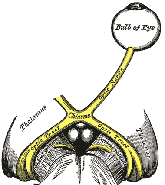
Home

Lab Tour

Lab Syllabus

Papers

Symposium
 Resources Resources
-
-
|
-

Lab 1: Membrane Diffusion Potentials
[Reading] [Overview] [Useful Links] [Lab Report] [Further Study]
Pre-lab reading
- Lab manual - pages 7-16
- Vander, Sherman, and Luciano - Section B: Membrane Potentials, Appendix D: Electrophysiology Equations.
Overview
The concept of "animal electricity" was discovered in the late 1700s by Luigi Galvani, an anatomy professor in Bolgna, Italy. He dissected a frog leg and found that by touching zinc and copper rods to an isolated nerve and muscle he could cause the muscle to contract. In those days, before the invention of the battery and electrical meters, his frog preparation was the state-of-the-art tool for studying electrical currents. We will spend the next month investigating how his "animal electricity" is key to an elegant system of high-speed communication among cells in the body, responsible for sensory input, integration of information within the central nervous system, and motor control of muscle. But before we get into the transmission of information, we'll start this week with an investigation of how an electrical potential across a membrane is created in the first place.
The electrical potential difference observed across the plasma membrane depends on three features of cells:
- The cytoplasm and extracellular fluid contain ions of various types (e.g., Na+, Cl-, K+, Ca+2) that differ in their concentration across the plasma membrane.
- The plasma membrane is selectively permeable to these ions. The permeability of each ion depends on the number and status (open or closed) of the channels for each ion.
- The distribution of ions across the plasma membrane is maintained by transporters or "pumps."
In the simplest case of a membrane permeable to a single ion, the Nernst equation can be used to predict the electrical potential across the membrane based on the concentrations of the ions on each side of the membrane.
In this lab, you will use a physical model of a cell, called a Ussing chamber, with a selectively permeable artificial membrane. With this model, you can vary the concentration of a single anion or cation across the membrane and measure the effects on the electrical potential. The questions you will investigate include:
- Is the artificial membrane permeable to cations or to anions?
- How does the membrane potential respond to changes in ion concentration on the two sides of the membrane?
To see pictures of the equipment and how it is used, visit the
lab tour page.
Useful Links
Lab Report
The lab report should include the following:
Introduction: One paragraph describing the experiment you designed and your hypothesis.
Results: One paragraph summarizing your results, accompanied by the dataset and graph from the Excel workbook and the statistical output from StatView.
Discussion: Compare your results with your hypothesis. Discuss the implications of any significant deviations from your prediction.
(see Lab Write-up section in your lab manual for more instructions)
Further Study at Berkeley
Courses related to this lab topic
MCB160. Introduction to Neurobiology
MCB160L. Neurobiology Laboratory
- Faculty doing research related to this lab:
Ehud Isacoff (MCB) Ion channel function and synaptic plasticity
- Robert Zucker (MCB) Cellular neurophysiology, synaptic biophysics
Links on these pages to commercial sites do not represent endorsement by the University of California or its affiliates.
IB 132 Lecture Website
Department of Integrative Biology
U. C. Berkeley
-
-
-
Last updated 1/13/06
- Copyright © Department of Integrative Biology. All rights reserved 2006
-
-
|
|